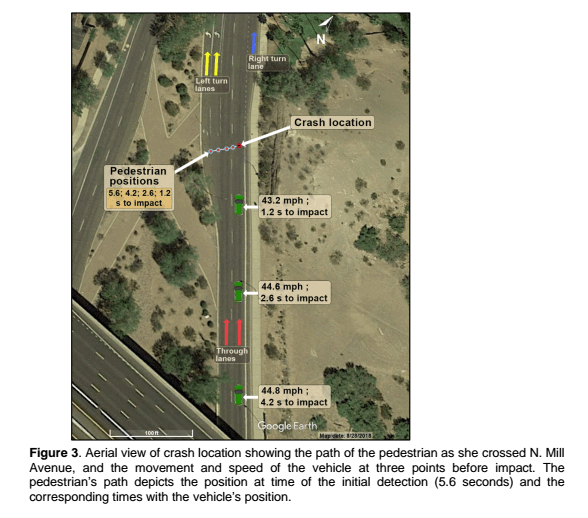Self-Driving Uber That Killed Pedestrian In 2018 Couldn’t Detect Jaywalkers, NTSB Says
An Uber vehicle that struck and killed a pedestrian in March 2018 had what are being called “serious software flaws” that led to the tragic incident.
The vehicle reportedly didn’t have the ability to recognize jaywalkers, according to a new report from engadget, who cited a report prepared by the NTSB. The safety agency blamed Uber’s software for not being able to recognize the victim of the accident as a pedestrian crossing the street. The vehicle didn’t calculate that it could potentially collide with the woman until just 1.2 seconds before impact, at which point it was too late to brake.
The NTSB said that Uber’s system “did not include a consideration for jaywalking pedestrians.”
In fact, the report says that the system detected her about 6 seconds before impact, but didn’t classify her as a pedestrian:
Although the [system] detected the pedestrian nearly six seconds before impact … it never classified her as a pedestrian, because she was crossing at a location without a crosswalk [and] the system design did not include a consideration for jaywalking pedestrians.
After recognizing the pedestrian (too late) the vehicle then wasted a second trying to calculate an alternative path or allowing the driver to take control. Uber has since eliminated this function in a software update.
Uber vehicles have failed to identify roadway hazards in at least two other cases, the report notes. In one, a vehicle struck a bicycle lane post that had bent into a roadway. In another, a driver was forced to take control of the vehicle to avoid an oncoming vehicle. The driver still wound up striking a parked car.
In the 7 months leading up to the pedestrian accident, Uber vehicles had been involved in 37 accidents, 33 of which involved other vehicles striking Uber test cars.
Uber began using “significantly revised software” in December 2018 when it began testing again. Simulating the Arizona incident with the new software, Uber said it would have now detected the pedestrian 289 feet before impact and would have had four seconds to brake before impact at a speed of 43.2 mph.
“The average stopping distance for a human is about 130 feet at that speed, including reaction time,” the report notes. This means that the vehicle would have likely been able to stop and avoid the accident.
Meanwhile, the NTSB plans on meeting on November 19 to determine the cause of the accident. Prosecutors have absolved Uber of liability but are still weighing the idea of criminal charges against the driver.
You can read the full NTSB report on the incident here.
Tyler Durden
Thu, 11/07/2019 – 19:25
![]()
Zero Hedge’s mission is to widen the scope of financial, economic and political information available to the professional investing public, to skeptically examine and, where necessary, attack the flaccid institution that financial journalism has become, to liberate oppressed knowledge, to provide analysis uninhibited by political constraint and to facilitate information’s unending quest for freedom. Visit https://www.zerohedge.com

